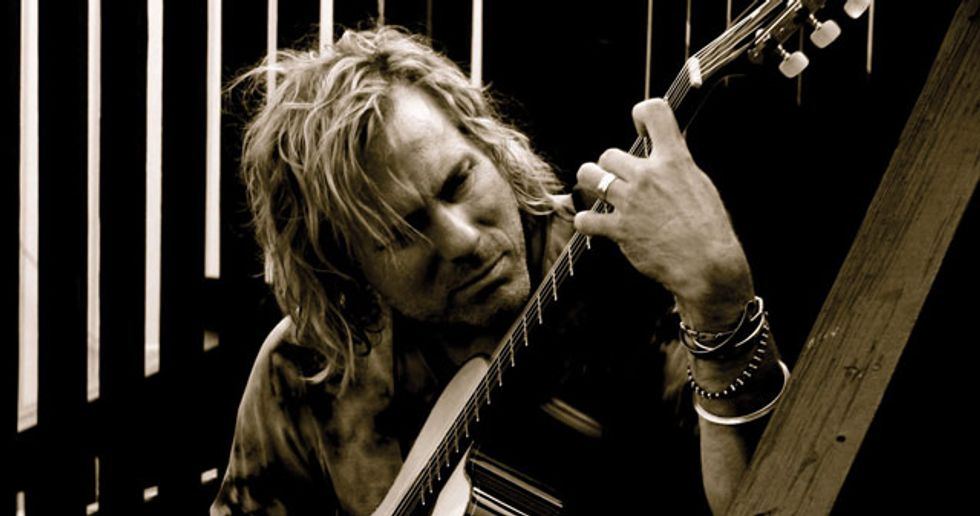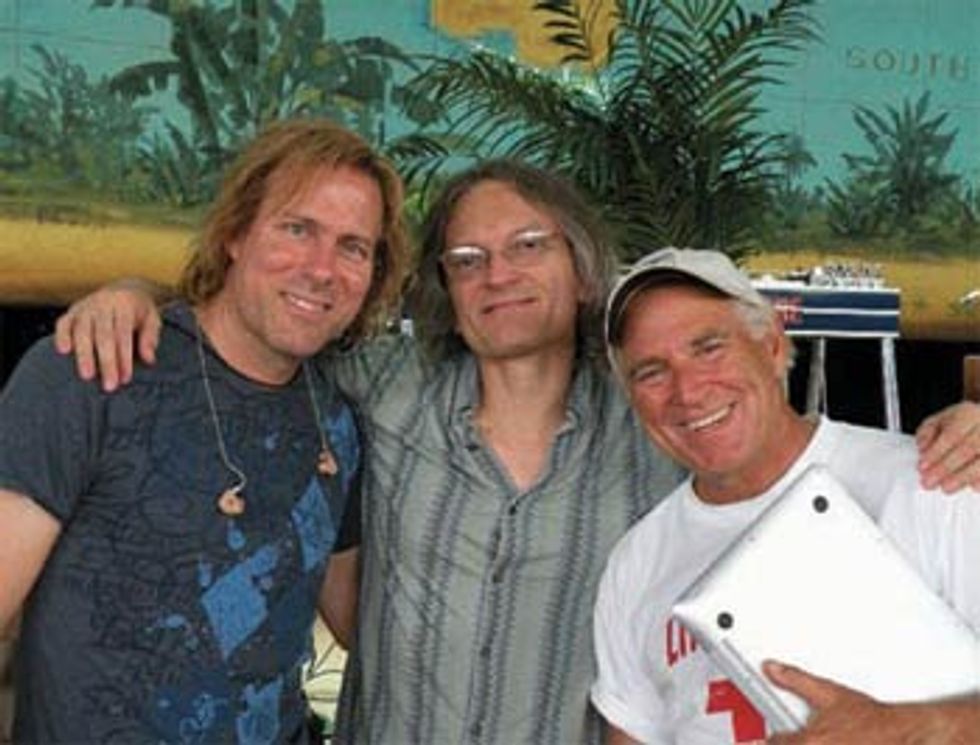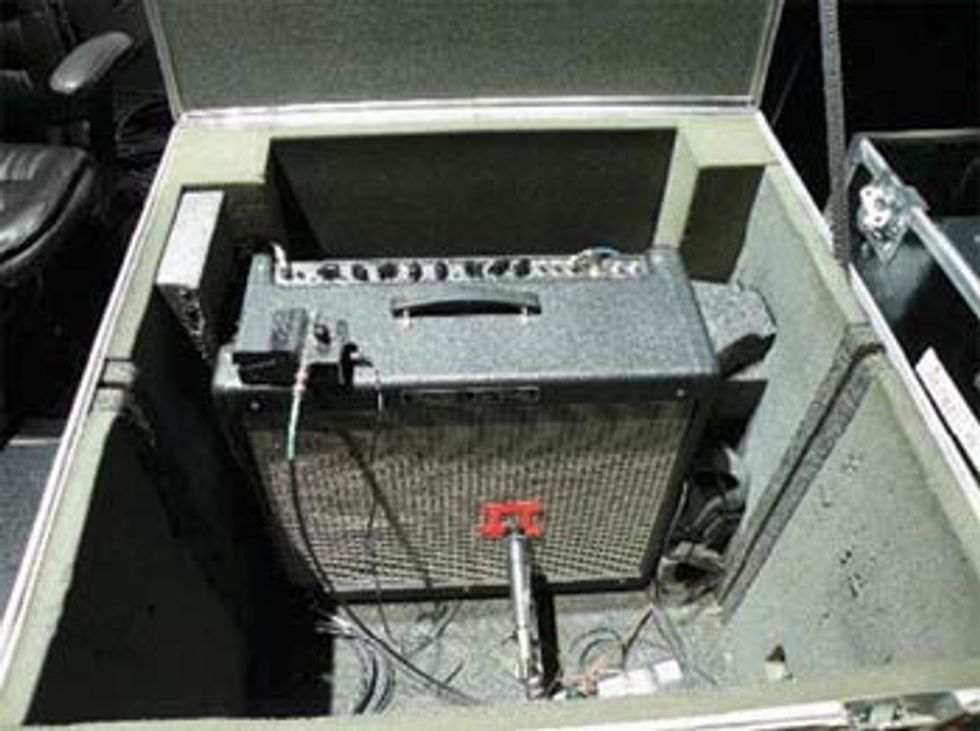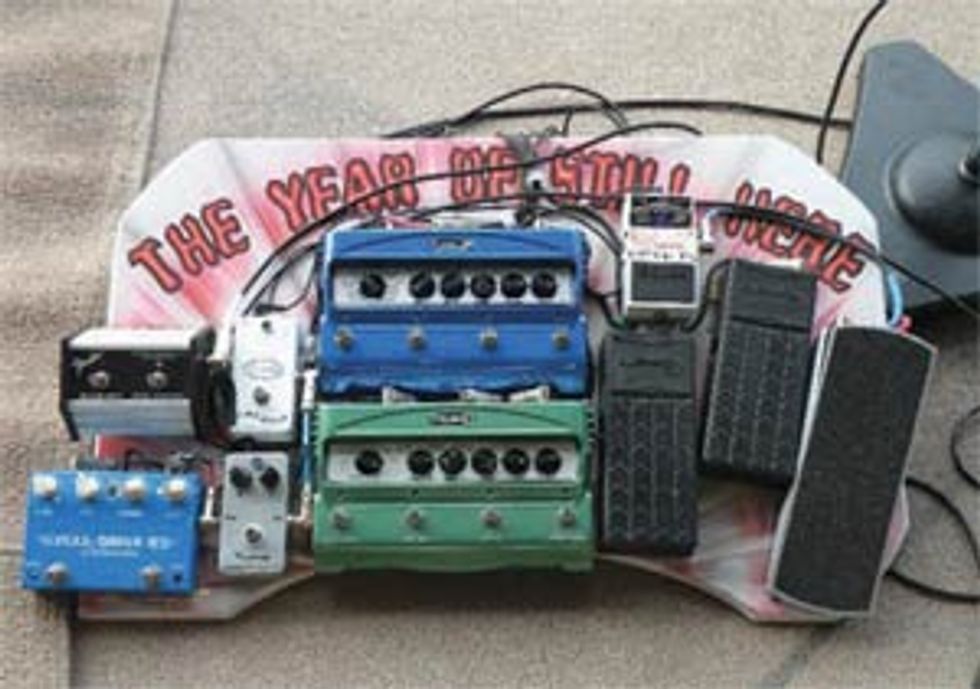
|
| Click here to watch our video of Peter taking us through his rig, then click here to watch him demo''ing his custom Martin. |
 | |
|
We recently had the chance to chill with Mayer backstage at a Buffett show, where he chatted gear and gigs with us before taking us through his entire rig (see the video).
You play with some killer musicians, man. I imagine that has an effect on your own approach as a player.
It does. I’ve scaled back my ego—I say that in kind of a funny but humble way. I’ve worked with Weckl and different people where it’s all about chops and really knowing your neck and all that stuff and I’m very thankful for that experience. I’ll be honest with you, when I got into this band 20 years ago, there were times when they’d say, “Hey, we don’t need so much on that,” and, “You can lay off there.” And I kept trying to just push, push.
But after awhile it starts to make sense.
I’m playing with guys like Mac [McAnally] and Jimmy [Buffett] and maturing and meeting more players like Joe Walsh. Sonny Landreth plays with us all the time. I watch him and it’s like, “Oh my gosh, man! It’s in the hands.” It’s all about the hands. But yeah, being humble was huge. I eventually learned to pick up the song verbatim as simply as I could, and sure enough out of all that I always learned something. It’s almost like you can’t be too wise about this stuff, you’ve got to go and be humble and pick up the new lesson. It may be a simple thing like—oh, you can bend that note that way—which makes this little emotional thing come out. That’s a beautiful thing. This gig has been great for me for that.
What’s your approach to solos? Anyone who has tried to learn the second solo to “Bama Breeze” has got to wonder how you do it. How do you come up with that stuff?
I don’t know, but thank you very much. It probably has a lot to do with the way I practice. I do this thing where I try not to play through my fingers but play from my heart or play from my ears. I force myself to sing what I’m playing so I can hear things in different ways. It’s all about identifying and getting past limitations— forcing myself to learn in different ways. Sometimes I just tape myself singing and then learn what I sang that way. You’re always guaranteed to get something fresh and it never sounds like someone else’s solo.
By the same token, I do encourage guitar players to play with their hands. In other words, play around a little bit and discover what your hands can do. There’s a beauty in the way your hands are shaped—no one else has got that, so you’re going to make a different tone, which guarantees us each if we practice, if we spend the time on it, each of us is going to bring out our own tone.
 | |
|
Actually, Jimmy depends on us doing that, to bring something fresh to this gig, you know what I mean? And I’m just curious in nature. I love to sing, I love to play and I love to write lyrics, too. It’s all just an expression of who I am and what I do. I’d go crazy if I just had one thing. I just don’t want to get stale, you know? Variety brings me peace. Ever since I heard the Beatles and I heard classical music and rock and roll and Bo Diddley, I’m just so jazzed by music—it’s the way I think the world keeps its sanity.
Tell me about the new acoustic that you and Dick Boak put together?
It’s incredible. First of all, Dick is incredible. He’s always been right there whether it’s for charity work, for helping us out as artists with our guitars or anything. So, thank you, Dick.
Okay, so Mac came to me and said he noticed I was playing up on my neck a lot and that it looked like I couldn’t quite get there with my regular cutaway. He had heard that there was something called a Schoenberg cutaway in the Martin books, so we went to Dick and asked him to build a couple and he did.
 | |
|
I understand Mac McAnally’s custom Martin didn’t fare so well.
What happened to Mac’s is, after a couple of months it was starting to open up because he was playing it a lot. That’s when it got squashed between two road cases. I tell you, there was nothing left of that thing. We’re talking toothpicks. He ordered a new one though and it’s phenomenal, as well.
What kind of pickup did you go with in your Martin?
I’ve been a Fishman guy all my life. I’ve got an Ellipse system with a mic in there right now. I’ve used the mic a little bit but I’ve got to tell you, the pickup sounds phenomenal. I’ve got an Infinity system on the way, I’m excited to try that out, too.
Last question—is there one that got away?
Oh yeah, man! I know exactly what you mean. When you said that I felt a pain right here in my back. I had a Gibson L-5. It was a beautiful blond, jazz guitar. I don’t know what year it was, but it must have been like a ’63 or ’64. It was beautiful. It had gold hardware and it just sounded incredible! I was a young pup and I didn’t know what to do with it. Pat Metheny started playing a new guitar synth so I traded that for a Roland guitar synth. Nothing against Roland, of course, because I still use their guitar synth and their VG88 system in my own band, but that was probably the dumbest trade I’ve ever made. That guitar today might be worth about 40 grand, but more importantly, it was just a beautiful soulful guitar. That’s my one that got away.
Peter’s Gearbox
|
Peter Mayer









![Rig Rundown: Russian Circles’ Mike Sullivan [2025]](https://www.premierguitar.com/media-library/youtube.jpg?id=62303631&width=1245&height=700&quality=70&coordinates=0%2C0%2C0%2C0)













![Rig Rundown: AFI [2025]](https://www.premierguitar.com/media-library/youtube.jpg?id=62064741&width=1245&height=700&quality=70&coordinates=0%2C0%2C0%2C0)




















 Zach loves his Sovtek Mig 60 head, which he plays through a cab he built himself at a pipe-organ shop in Denver. Every glue joint is lined with thin leather for maximum air tightness, and it’s stocked with Celestion G12M Greenback speakers.
Zach loves his Sovtek Mig 60 head, which he plays through a cab he built himself at a pipe-organ shop in Denver. Every glue joint is lined with thin leather for maximum air tightness, and it’s stocked with Celestion G12M Greenback speakers.











